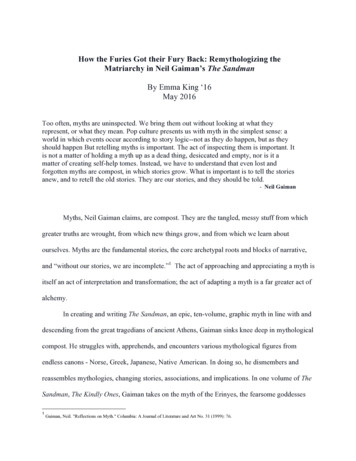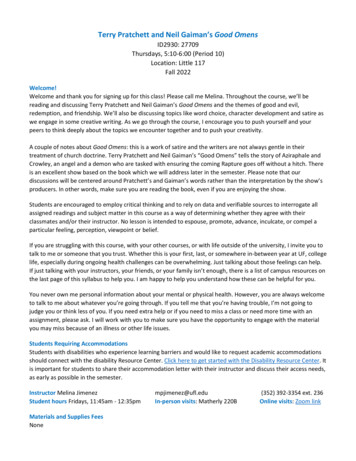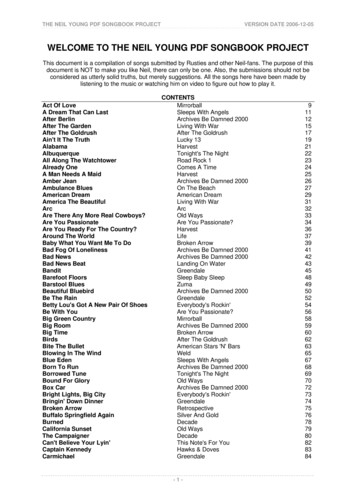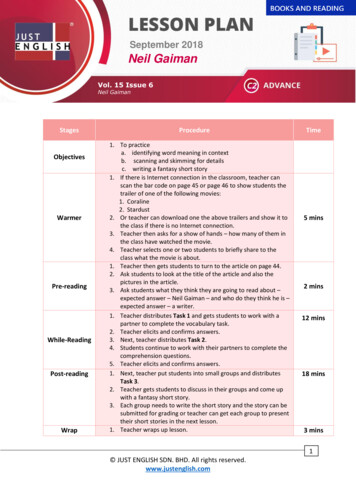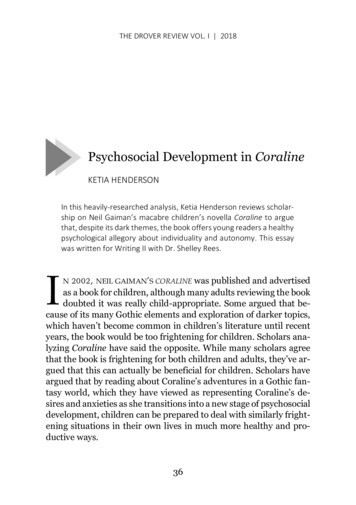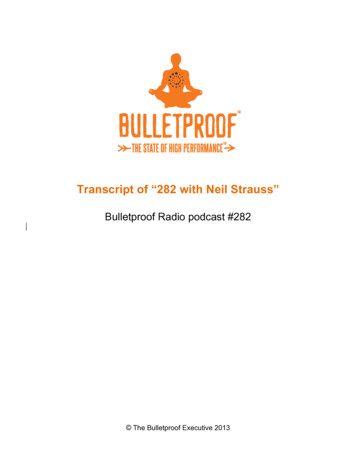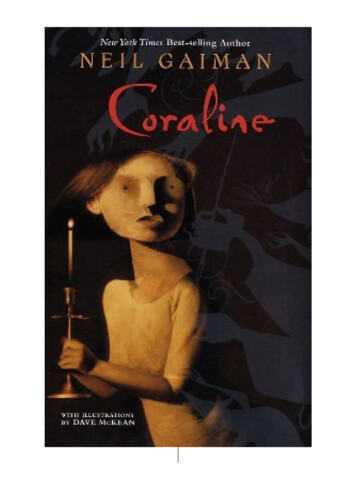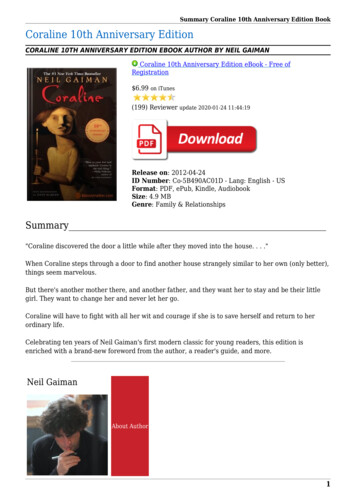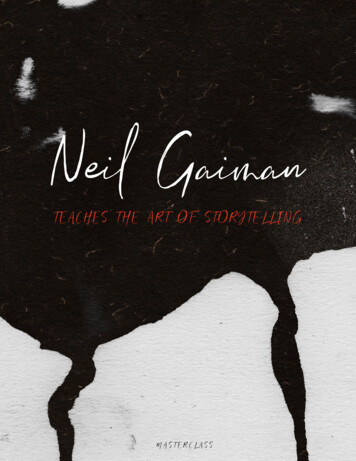
Transcription
Neil GaimanTEACHES THE ART OF STORYTELLINGMASTERCLASS
"I want to take you into a lot of thenuts and the bolts and the dibbers andthe switches and the flashing lights andthe mousetraps and the doomsday devices,and I want to walk you through thatsafely and have you coming out of thatgloriously garbled mess of a metaphor withactually a rather better idea of how towrite than you had when you started."
NEIL GAIMANCHAPTER 01IntroductionMASTERCLASS
M E ET YO U R N E W I N ST RU C T O R:Neil GaimanImake things up and write them down” is the wayNeil Gaiman describes his varied art, and as a“feral child raised in libraries,” he credits librarianswith fostering a lifelong love of reading. Today, as oneof the most celebrated writers of our time, his popularand critically-acclaimed works bend genres whilereaching audiences of all ages and winning awards ofall kinds. The Graveyard Book is the only work everto win both the Newbery (US) and Carnegie (UK)Medals, awarded by librarians for the most prestigiouscontribution to children’s literature, and Neil's bestselling contemporary fantasy novel, American Gods, tookthe Hugo, Nebula, Bram Stoker, and Locus awards, asdid his young adult novel Coraline. The Dictionary ofLiterary Biography lists him as one of the top ten livingpostmodern writers. Born in England, Neil lives in the“United States and taught for five years at Bard College,where he is a Professor of the Arts. He is married toartist/musician Amanda Palmer.In graphic novels, Neil's groundbreaking workSandman, which was awarded nine Eisner Awards,was described by Stephen King as having turnedgraphic novels into “art.” Hailed by the Los AngelesTimes as the greatest epic in the history of the form, anissue of Sandman was the first comic book to receiveliterary recognition when given the World FantasyAward for Best Short Story.Many of his books and stories have been adaptedfor film and television. Coraline, a 2009 stop-motionanimated film directed by Henry Selick, was an Oscar4
NEIL GAIMANCHAPTER 01nominee for Best Animated Film and secured a BAFTAin the same category. Matthew Vaughn directed a 2007film based on Neil’s novel Stardust, starring ClaireDanes and Robert De Niro. The Emmy-nominatedadaptation of American Gods is in its second seasonon Starz and most recently, Neil scripted an Amazon/BBC six-part series based on the novel Good Omens,which he cowrote with the late Terry Pratchett.His many honors include the Shirley Jackson Award,Chicago Tribune Young Adult Literary Prize (forhis body of work), Comic Book Legal DefenseFund Defender of Liberty award, and an HonoraryDoctorate from the University of the Arts, one of theoldest American universities dedicated to the visualand performing arts and design. In 2017, UNHCR,the UN Refugee Agency, appointed Neil Gaiman as aglobal Goodwill Ambassador.MASTERCLASShow to subvert the expected, and how to weave disparate ideas into something unique and fresh.Chapters 9 and 10 will tackle the deeply interwovenaspects of dialogue and character while Chapters 11-14will help you build the world of your story. In Chapter15, you'll see Neil's process for drafting stories in thecomic format. The final four chapters will providepractical advice for the writer’s life—everything fromediting to overcoming writer’s block.Throughout, Neil sends a plumb line into writing’sdeeper subjects—the social importance of storytelling,where inspiration comes from, and what to make ofthe great contradiction of using lies to reveal the truth.These questions, which lie at the center of writing, canoften reveal just the right thing to the writer who hasbecome stuck or who is looking for an evolution oftheir craft.ABOUT NEIL’S MASTERCLASSHumans are fundamentally storytelling creatures.Whether you’re talking to a friend or penning a novel,you’re using the same tools to form a connection withpeople, to entertain them, and to make them thinkdifferently about the world.As a writer, Neil is an explorer. His approach to writingencompasses a broad range of storytelling skills andoffers useful tools for all kinds of writers at all stages ofdevelopment.This MasterClass will give you access to Neil’s literarytoolbox, which contains quite a complex collection. Inthe first eight chapters, you’ll cover the basics, suchas developing character, creating conflict, and determining your story’s main themes and concerns. You’lluse short stories to learn about economy and backstory,but also as a way to generate a reader’s interest. Neilprovides ample case studies, including comic books,that analyze character and story structure. Most of all,you’ll learn the signature aspects of Neil’s craft: howto push your story beyond a single genre or influence,INTRODUCTIONThis book was created by MasterClass as a supplementto Neil's class.RECOMMENDED READING:NEIL’S WORKNeil has written a staggering variety of work in multiple mediums. If you haven’t read his work yet, pick upany of the following titles. Although not required, theywill benefit you throughout the class. The Sandman Vol. 1: Preludes and Nocturnes (1988)The Sandman: Dream Country (1991)Neverwhere (1996)Stardust (1999)American Gods (2001)Coraline (2002)The Graveyard Book (2008)The Ocean at the End of the Lane (2013)Trigger Warning: Short Fictions and Disturbances(2015) Norse Mythology (2017)5
NEIL GAIMANCHAPTER 01Additional ReadingThis workbook references important elements fromother books to supplement Neil’s teachings. You maywant to obtain copies of the following: Story: Substance, Structure, Style, and the Principlesof Screenwriting by Robert McKee (1997) The Art of the Short Story: 52 Great Authors, TheirBest Short Fiction, and Their Insights on Writing byDana Gioia and R.S. Gwynn (ed.) (2005) The Making of a Story: A Norton Guide to CreativeWriting (2007) by Alice LaPlanteINTRODUCTIONMASTERCLASSWRITING EXERCISESThe coursework in this book is divided into twosections. Writing Exercises offer everyone a chance topractice the tools Neil teaches in this class. For YourNovel sections will apply Neil’s tools to the process ofwriting a novel. They will be most helpful for writerswho are starting a novel or who are in the midst oflonger works. If you’ve already finished a novel, thesesection will help you strengthen your work.Keep a separate notebook for this course. The writingexercises will ask you to work on assignments thatbuild on previous ones. If you’re working on a novel,having a notebook devoted to this course will give youspace to develop new and experimental aspects of yourwork.6
NEIL GAIMANCHAPTER 02Truth in FictionMASTERCLASS
NEIL GAIMANMASTERCLASSCHAPTER 02Truth in Fiction“We’re using memorable lies. We are taking people whodo not exist and things that did not happen to thosepeople, in places that aren’t, and we are using thosethings to communicate true things.”Using the “lie” of a made-up story to reach ahuman truth is one of the central tools of literature. Samuel Taylor Coleridge explained that inorder to sink into and enjoy a story, an audience musthave “poetic faith”—meaning that they must be willingto accept that the story they are hearing is a facsimileof reality. In order to encourage a reader’s “willing suspension of disbelief,” writers strive for verisimilitude.(Today, Stephen Colbert would call this “truthiness.”)The goal is to be credible and convincing. This can beof a cultural type—a book that portrays the real worldis said to have cultural verisimilitude—or of the genretype—a fantasy that portrays an imaginary world withenough internal consistency that it feels real is saidto have generic verisimilitude. It doesn’t matter howoutlandish the world of your story is, it should feel realto the reader.Use the following tools to strengthen verisimilitude inyour characters, settings, and scenes.Provide specific, concrete sensory details: You canmake up an underground tunnel that doesn’t exist, butif you describe the smell of sewage and the persistentdripping of water, you draw your reader into a concrete experience that contributes to the sense of reality.“What you’re doing is lying, butyou're using the truth in orderto make your lies convincingand true. You’re using them asseasoning. You’re using the truth asa condiment to make an otherwiseunconvincing narrative absolutelycredible.”Focus on emotions that are true to your characters:Your hero might be fighting an impossible beast, buteveryone will be able to relate to their fear.Incorporate the familiar alongside the unfamiliar:Keeping the reader grounded in things they recognizeis just as important as introducing new and interestingelements.Avoid technical mistakes: If you’re writing aboutthe real world, get the facts straight. If you’re writinga magical world, stay consistent with the laws of yourcreation.8
NEIL GAIMANCHAPTER 02Take time to cover objections: If something isn’t rightin your world, let your characters notice that it isn’tright for them either.Most of the time, truthiness is not something to strivefor, but in fiction it serves a higher purpose of conveying emotional truths to your reader in a way thatwill entertain them, help them through difficult times,make them think differently about the world, or evenchange their lives.To understand more about verisimilitude, study thecounterfactual genre. These books tackle “what if ”questions, such as “What if Hitler had won the war?”They set their stories in a familiar reality that is twistedin some meaningful way, coupling the familiar andunfamiliar. The following books provide examples ofhow writers can finely balance reality and imagination,and transport their readers to amazingly believableworlds. The Man in the High Castle (1962) by Philip K.Dick—What if America lost World War II? The Alteration (1975) by Kingsley Amis—What ifthe Reformation had never happened? Fatherland (1992) by Robert Harris—What if Hitlerhad won the war? The Plot Against America (2004) by Philip Roth—What if the U.S. struck an entente with Hitler? The Yiddish Policemen’s Union (2007) by MichaelChabon—What if a Jewish state had been established in Alaska?MASTERCLASSFOR YOUR NOVELChoose a page or scene from your work-in-progressand analyze it for verisimilitude by answering thefollowing questions:Are your descriptive details specific? Can you makethem sensory?Is your character’s behavior in line with their personality? Do their responses make sense for them?Can you fact-check anything? If so, do it now.“If you’re going to write. you haveto be willing to do the equivalent ofwalking down a street naked. Youhave to be able to show too muchof yourself. You have to be just alittle bit more honest than you’recomfortable with.”Essays are a natural way to learn more about individual writers and how they view their subject matter.The voices you’ll encounter in essays tend to be morepersonal than the ones you’ll find in novels or shortstories. The essay collections below provide plentyof great topics to encourage your own thoughts. Doyou agree with the authors' opinions? If not, write aresponse or an essay of your own. Try to “show toomuch of yourself.” Underground Airlines (2016) by Ben Winters—What if slavery had never ended in America?TRUTH IN FICTION9
NEIL GAIMANCHAPTER 02 Tremendous Trifles (1909) by G. K. Chesterton Notes of a Native Son (1955) by James Baldwin Slouching Towards Bethlehem (1968) by Joan Didion Ex Libris: Confessions of a Common Reader (1998)by Anne Fadiman The Wave in the Mind: Talks and Essays on theWriter, the Reader, and the Imagination (2004) byUrsula K. Le Guin Consider the Lobster (2005) by David Foster Wallace The Braindead Megaphone: Essays (2007) by GeorgeSaunders Magic Hours: Essays on Creators and Creation(2012) by Tom BissellMASTERCLASS“All fiction has to be as honest as youcan make it. because that’s whatpeople respond to.”WRITING EXERCISETo practice honesty in your writing, choose one ofthe following moments and write a few paragraphs inyour journal about it. As you write, pay attention toyour inner register about what you’re writing, notingthe particular things that make you uneasy. Try to bea little “more honest than you’re comfortable with.”Remember that being brave doesn’t mean you’re notscared; it means you do it anyway. A time when you were deeply embarrassed.When you regret something you did.The saddest moment of your life.A secret you are afraid to talk about. The Empathy Exams (2014) by Leslie Jamison The View From the Cheap Seats (2016) by NeilGaiman Animals Strike Curious Poses (2017) by ElenaPassarelloTRUTH IN FICTIONTake the work you wrote above and either read it aloudto someone you trust, or read it alone and pretend thatyou have an audience. Listen to the way you sound andpay attention to the sensations in your body as you’rereading the difficult moment. Consider what you’reafraid of being judged for, or afraid of saying out loud.Write those things down.10
NEIL GAIMANCHAPTER 03Sources of InspirationMASTERCLASS
NEIL GAIMANMASTERCLASSCHAPTER 03Sources of Inspiration“Remember that your influences are all sorts of things.And some of them are going to take you by surprise. Butthe most important thing that you can do isopen yourself to everything.”An allusion is a short reference to another story,usually through the use of well-known elements.For example, you can quickly reference Alice’sAdventures in Wonderland (1865) by mentioning awhite rabbit. Allusions generate interest because theyset a context for the story you’re reading while hintingat the similarities or differences in the two works. Neiluses allusions often, and they are just as wide-rangingas his storytelling interests, referencing Egyptian andGreek mythology, Victorian fairy tales, Beowulf andNorse mythology, Shakespeare, Tolkien, and moderncinema, to name a few. In this chapter, Neil mentionshis admiration for the following authors, and sometimes alludes to them in his own work:James Branch Cabell: American author who wrotefantasy and comedy in the 1920s and '30s. His mostenduring work, Jurgen: A Comedy of Justice (1919), tellsthe story of pawnbroker-poet Jurgen who journeysthrough various fantasy worlds to find justice whilebecoming more and more disillusioned. It is a parodyof romance tales and courtly love.Edward Plunkett, Lord Dunsany: A prolific AngloIrish fantasy author. His novel, The King of Elfland’sDaughter (1924), established some of the most centralthemes of fantasy writing in the twentieth century:elves, witches, trolls, hidden worlds with different timestreams, and a preoccupation with nature and powerful magic. In Neil’s Stardust, Tristan moves beyond“the fields we know”—a phrase that alludes to Elfland’sDaughter.Ursula K. Le Guin: American author who wrote theEarthsea Cycle (1968-2001), which is comprised of sixbooks and numerous short stories, and which tells talesof the fictional fantasy world of Earthsea. LeGuin’swork centers on themes of gender, power, responsibility, the natural world, and death. Her novel, The LeftHand of Darkness (1969), was one of the first fantasynovels to influence Neil. In an article he wrote for theLibrary of America, he said that “the trilogy made melook at the world in a new way, imbued everythingwith a magic that was so much deeper than the magicI’d encountered before then. This was a magic of words,a magic of true speaking.”12
NEIL GAIMANCHAPTER 03P. L. Travers: British author who wrote Mary Poppins(1934) and a whole series of books inspired by it (evena cookbook). If you’ve only seen the Disney movie, it’sworth checking out the novels, which are darker andmore fantastical. Mary is constantly looking in mirrorsto make sure she’s real; she can talk to animals; and atone point even dances among the stars. For children,she is the guardian to a world of frightening magic.Neil suggests many tools for approaching an oldstory from a new angle.Change point of view: Choose an alternate characterto retell a familiar story. In the novel Foe (1986), J.M.Coetzee narrates the tale of Robinson Crusoe from thepoint of view of Susan Barton, a castaway who washedup on the island in the middle of Crusoe’s adventures.MASTERCLASSFor a re-envisioning of popular fairy tales, check outsome of the following titles. (Titles with asteriskscontain stories by Neil.) Red as Blood (1983) by Tanith Lee Tales of Wonder (1987) by Jane Yolen Snow White, Blood Red (1993) by Ellen Datlow andTerri Windling (ed.)* Kissing the Witch: Old Tales in New Skins (1999) byEmma Donoghue The Wilful Eye (2011) edited by Nan McNab (ed.) Happily Ever After (2011) by John Klima (ed.)*Modernize themes: A lot of classic tales get a gender-based upgrade, where an author will delve into afemale character’s head from a more modern perspective. Margaret Atwood’s novella The Penelopiad (2005)revisits Homer's Odyssey through the eyes of Penelopeand her chorus of twelve maids. Clockwork Fairy Tales: A Collection of SteampunkFables (2013) by Stephen L. Antczak (ed.)Switch a story element: This could mean taking astory to a new location—Cinder (2012) by MarissaMeyer re-imagines Cinderella as a cyborg in Beijing—or changing the type of story—In The Snow Queen(1980), Joan D. Vinge turns Hans Christian Andersen’sclassic tale into a space opera. The Starlit Wood (2016) by Dominik Parisien andNavah Wolfe (ed.) Unnatural Creatures (2013) by Neil Gaiman (ed.)* Beyond the Woods (2016) by Paula Guran (ed.)* The Djinn Falls in Love and Other Stories (2017) byMahvesh Murad and Jared Shurin (ed.)*Make it yours: Take a familiar story and add in a bit ofyour own background or experience. Mario Puzo didthis with panache in The Godfather (1969), bringingelements of Shakespeare’s Henry IV to the world heknew well: Italian immigrants in post-war America.SOURCES OF INSPIRATION13
NEIL GAIMANCHAPTER 03WRITING EXERCISEChoose a folk tale or fairy tale that you know well.Select one of the characters from the story for thefollowing exercise and write a few pages about them,using one of the following prompts: Pretend you’re a therapist treating the character.Write a scene in which you discuss the character’slife and problems, then arrive at a diagnosis. Write a newspaper article describing the eventsof the story. For example, Snow White—WomanHiding in Woods for Ten Years Found by WealthyHiker. Then write a story for that headline usingjournalistic objectivity. Have your character explain their actions to a jury.“I think it’s really important fora writer to have a compost heap.verything you read, things thatyou write, things that you listen to,people you encounter, they can allgo on the compost heap. And theywill rot down. And out of them growbeautiful stories.”In Writing Down the Bones (1986), author NatalieGoldberg argues that “it takes a while for our experience to sift through our consciousness” and that oursenses “need the richness of sifting” in order that wecan “see the rich garden we have inside us and usethat for writing.” She coined the term “composting” todescribe this process of allowing the unconscious andSOURCES OF INSPIRATIONMASTERCLASSconscious minds to process experience before sharingor re-inventing it in writing. Many writers practicecomposting in one form or another—usually by collecting various things that inspire them and assemblingthem in a journal, folder, or online file. Rereading yourcompost heap can not only give you time to processdifficult subjects, it can trigger fresh inspiration andhelp you make creative leaps by linking up seeminglydisparate elements.WRITING EXERCISEIn your journal, begin creating a compost heap. Titlea page “Compost Heap” and write down the thingsthat have captured your attention in the past weekor month. These may become the source motivatorsof your writing, maybe of your career. Any writingproject is an undertaking, and novels in particular,because they take so long to write, will require asustained interest, so be sure to fill this page with yourtruth: What interests you? This can be anything: aword, a movie, a person, an event, so long as it inspiredyou. It can be subjects (cactus species, muscle cars, avoyage to Mars) or people/types of people (therapists,spies, your Aunt Germaine). Try to include things fromother arts—for example, foods, music, or movies. Inthe beginning, make a practice of sitting down at leastonce a day to note things that interest you.FOR YOUR NOVELCreate a specialized subset of your compost heap,which is a lexicon devoted exclusively to your novel.For example, if you’re writing about Greenland, gatherall the words you can about snow, ice, flora and fauna,geologic formations, or weather occurrences. Researchhistory and arts and science. Write down all of thewords you love and that you think could go into yournovel.14
NEIL GAIMANCHAPTER 03“You get ideas from two thingscoming together. You get ideasfrom things that you have seen andthought and known about and thensomething else that you’ve seen andthought and known about, and therealization that you can just collidethose things.”SOURCES OF INSPIRATIONMASTERCLASSOne of the big questions Neil raises in this chapter isthe origin of ideas and inspiration. Neil posits thatideas come from confluence, or the peculiar combinations of thoughts and experiences that are uniqueto you. Many writers would agree. Others have foundideas in dreams (Stephen King and Stephanie Meyer),in sudden flashes of inspiration (J.K. Rowling), in acasual joke (Kazuo Ishiguro), while doing a mundanetask like visiting a yard sale (Donna Tartt) or whilegrading papers (J.R.R. Tolkien). Still others findinspiration in the people they know (P.G. Wodehouse,Agatha Christie, and Ian McEwan). Roald Dahl kept anIdeas Book (his own compost heap) and found an ideafor a novel from an old comment he’d written manyyears before. In her book Big Magic (2015), ElizabethGilbert goes so far as to say that ideas are a “disembodied, energetic life form” and that creativity “is a forceof enchantment like in the Hogwarts sense.” In orderto collaborate with these life forms, you must simplyengage in “unglamorous, disciplined labor” and write.15
NEIL GAIMANCHAPTER 04Finding Your VoiceMASTERCLASS
NEIL GAIMANMASTERCLASSCHAPTER 04Finding Your Voice“You’re going to write short stories that nobody reads,that don’t really work. That’s okay.After you’ve written10,000 words, 30,000 words, 60,000 words, 150,000words, a million words, you will have your voice becauseyour voice is the stuff you can’t help doing.”Your writing will develop its own style and personality, or your writer’s voice. It is the sum ofall the elements of your work that would makeit possible for someone to pick up a page of text andrecognize that you wrote it. It is not necessarily yourspeaking voice, rather it’s the voice that comes throughon the page. On a technical level, it is composed of thechoices you make regarding emotional tone, characters, settings, and the textual rhythms of your languagelike diction, sentence structure, and even punctuation.The sum effect of these things will be unique to youand will reveal your personality and attitude to youraudience.While each writer has their own voice, sometimes astory demands a voice of its own, called a persona,which is different from the writer’s voice. The personais the voice that tells the story and can be any narrativepoint of view from an omniscient, third person to aclose first person. You will generally find the personafor a story in the same way you develop a setting orcharacters. Neil gives three examples of persona in hisworks: The “American transparent” in American Gods—common among many authors, this style is so basicthat the author seems invisible. If style is made up of“the things you get wrong,” then this style is technically perfect, clean, and conservative. It serves thepurpose of keeping the focus on the story so thatyou might even forget that someone is telling a story. The old-fashioned “formal” voice in Stardust—anywriting style with syntax or vocabulary borrowedfrom an earlier time period. Very often, premodernways of speaking or writing feel stilted to a modernear, and this style uses that quality, often to take youback to a historical moment or to a different world. The cicerone in The Ocean at the End of the Lane—this persona is informal, close, and often not veryliterary. This style can mimic the feeling of beingwith an actual person who is explaining their storyto you.17
NEIL GAIMANCHAPTER 04One of the voices most writers try to avoid is “writerly”voice, which is an attempt to sound literary that cancome off as overwritten. This voice involves unnaturally complex sentence structures, too many adjectivesor rare words, and lengthy, unnecessary descriptions.Unless a specific character is in fact pompous andviews the world that way, work instead to develop yourown voice. Don’t be afraid to be yourself, no matterhow quirky you are. Writing is one of the places whereyour weirdness is welcome.MASTERCLASStoo much editing while you write, just let your ideasflow and then structure them once you’ve got everything on the page.“Each story has its own voice. Butthe attitude, the soul, the thing youtake away from it, hopefully that’sall me. And that can be all you.”WRITING EXERCISES“You learn more from finishing afailure than you do from writing asuccess.”On a page in your notebook, describe yourself as awriter. Pretend you are a different person explainingwhat your work is like to someone who has neverread it. This doesn’t have to be perfect, just write yourimmediate thoughts and impressions. If you’re struggling with this, re-read a few pieces of your writingand try to describe what they have in common. Whatsimilarities exist in your works? Think of the overtones (i.e. you always use the same genre or same typeof characters) as well as the quieter ones (i.e. attitude,emotional registers you use in your fiction, etc).Give a short selection of your writing to someone elseand ask them to describe it in three adjectives. Do theyrecognize you in the writing?Sometimes a fear of making mistakes will sabotageyour writing process. It may stop you from puttingideas on the page, or it can cause blocks while you’rein the middle of a project. To develop confidence,challenge yourself to write a short story in one sitting.You’re not allowed to go away from the project untilyou have a completed draft. It can be any length, buttell a complete story that will satisfy a reader. Don’t doFINDING YOUR VOICEFor his book The Sound on the Page (2004), Ben Yagodainterviewed 40 notable authors about their writer’svoices. His collection of essays is the perfect resourcefor learning about the many ways that writer’s voicecan be conveyed on the page.Certain writers are known especially for their voices.Read some of the following authors to sample a widevariety:Jane Austen: Master of irony and dialogue, Austen’spreoccupation with social divisions, and the witty andinsightful tone with which she reveals hypocrisy andparodies people contributed heavily to her voice.Ernest Hemingway: A pioneer of the concise, “masculine” style which came about because of his background in journalism and his general disillusionmentabout war.Zora Neale Hurston: Lyrical, spoken style of voice,borrowing heavily from the dialects of her life andexperiences. Read Their Eyes Were Watching God(1937) and you can hear the church hymns she grew upwith in the rhythms of her sentences.Kurt Vonnegut: Famous for simplicity of language anda dry wit, his voice has intelligence and a strong senseof decency that comes from his concerns with socialequality. (His essay "How to Write With Style" offerssound advice for any writer.)18
NEIL GAIMANCHAPTER 04Raymond Chandler: Famously wry, full of wisecracks, and partial to pithy similes, Chandler’s voicegrew tougher over time, thanks to his increasingdisillusionment and social criticism. His alienation andbleakness came to epitomize the noir genre. Read TheLong Goodbye (1953) for the richest of his work.Margaret Atwood: Her highly descriptive style isinspired by her love for poetry, myth, folklore, and thefantastic, and she weaves these elements into greaterthemes of power, feminism, and technology to producea distinctly trenchant voice.The type of writers that appeal to you can also revealthe type of voice you have. For fun, check out “I WriteLike,” (https://iwl.me/) a free online tool that allowsyou to analyze your own writing and tells you whichauthors you most resemble.MASTERCLASSWRITING EXERCISEChoose an author whose writing you admire and read afew pages of their work. Now write a passage in a voicethat mimics theirs, using characters, settings, and problems of your choice. What makes this author’s voice soappealing? How does it make you feel?Now write a paragraph or more on any topic of yourchoice. Make an effort to use a voice that feels morenatural to you. What sets your voice apart? What tonedoes it give? Do the characters and setting feel differentwhen you write in your own voice?READING EXERCISEWilliam Faulkner once famously advised young writersto “Read everything: Trash, classics, good and bad,and see how they do it.” Part of your apprenticeship islearning what you love and hate.Go to a library or bookstore and select five books fromauthors you’ve never read before (and perhaps knownothing about). Open each book to a random chapterand begin reading, observing which aspects of thewriter’s voice you enjoy, and which ones you dislike.Make a list of all the qualities you observe and noteyour feelings about them.FINDING YOUR VOICE19
NEIL GAIMANCHAPTER 05Developing the StoryMASTERCLASS
NEIL GAIMANMASTERCLASSCHAPTER 05Developing the Story“What is a story? Eventually what I decided was, thestory is anything fictional that keeps you turningthe pages and doesn’t leave you feelingcheated at the end.”Every story has a big idea, the thing that youwould say your story is about. Deciding on yourstory’s big i
Humans are fundamentally storytelling creatures. Whether you're talking to a friend or penning a novel, you're using the same tools to form a connection with people, to entertain them, and to make them think differently about the world. As a writer, Neil is an explorer. His approach to writing encompasses a broad range of storytelling .
